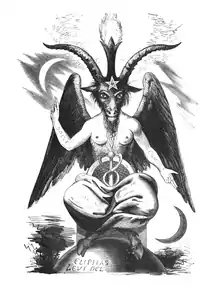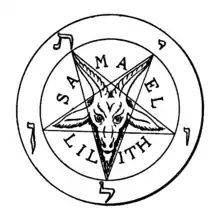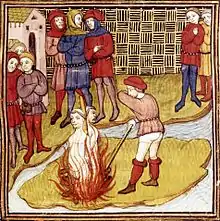بافومه
بافومت (/ˈbæfoʊmɛt/ به زبان لاتین: Baphometh , Baffometi به زبان اکسیتان:Bafometz) در اصل نمادی برای توصیف عقاید و یا خدایان شوالیههای معبد بود که متهم به پرستش آنها بودند. بعدتر این نمادها توسط فرقههای مخفی (فراماسونری) و آنها که ضد حکومت های مستبد مذهبی بودند نظیر شیطان پرستان مورد استفاده قرار گرفت.


بافومت در واقع از دو نماد رأسالجدی (محل خورشید در زمستان) و رأسالسرطان تشکیل شده و نمادی است از مادر (خورشید درون رحم (زمستان) و خورشید در حال پرورش (تابستان).

پیشینه
بافومت به عنوان نشانی برای پگان ها (اصطلاحی که در قرون وسطی، کافران را به آن نام می خواندند) در متنهای تفتیش عقاید شوالیههای معبد در قرن ۱۴ام میلادی به چشم می خورد.[1] لغت بافومت برای اولین بار در قرن ۱۹ام میلادی طی مناظرات و سخنرانیهایی که بر سر دلایل سرکوب شوالیههای معبد انجام میشد وارد فرهنگ لغات عامیانه انگلیسی شد.[2] از سال ۱۸۵۶ به بعد لغت بیشتر اشاره به "بز سباتیک" دارد که توسط الیفاس لوی تصویرسازی شد[3] که شامل عناصری جفت شده در خود بود و منظور از آن نظام جفت بودن موجودات در طبیعت (زن و مرد، شب و روز، خیر و شر و...) بود.[4] در روایتی از تاریخ نخستین جنگ صلیبی آمدهاست که ریموند آگویلرا، تاریخنویس فرانسوی مساجد را بافوموریا خوانده است.[5]
اصطلاح بافومتز بعدها در حوالی سال ۱۱۹۵ میلادی در شعری به زبان اکسیتانی مطرح شد.[6] در سال ۱۲۵۰ در شعری که به وصف جنگ صلیبی هفتم می پرداخت از کلمه بافومت استفاده شدهاست.[7] سرکوب شوالیههای معبد توسط فیلیپ چهارم در ۱۳ اکتبر ۱۳۰۷ آغاز شد او بسیاری از تمپلارهای فرانسوی را دستگیر نمود و اقدام به شکنجه و اعترافگیری از آنها کرد. در آن دوران اتهامات زیادی به شوالیههای معبد زده میشد که بیشتر آنها همان اتهاماتی بود که به کاتارها [8] و بیشتر دشمنان فیلیپ نسبت داده میشد. فیلیپ پیشتر پاپ بونیفاس هشتم را ربوده و او را متهم به ارتداد، تف و ادرار کردن بر روی صلیب و لواط کرده بود. بر اساس مدرکی که در سال ۲۰۰۱ از آرشیو واتیکان به دست آمد از اتهامات شوالیههای معبد ادرار بر روی صلیب بود.
برخی محققان جدید همچون پیتر پارتنر و مالکوم باربر معتقدند کلمه بافومت فرانسوی شدهٔ کلمه محمد میباشد. آنها این دلیل را بیان میکنند که با توجه به این که شوالیههای معبد مدت زیادی در بین مسلمانان ساکن بودند عقایدشان تحت تأثیر آنها قرار گرقته بود و شواهد و مدارک به جامانده از اعترافات شوالیههای معبد به ارتدادشان این موضوع را تأیید میکند.[9] آلن دمگیر محقق فرانسوی این عقیده که ممکن است شوالیههای معبد از اعتقادات دشمنان خود تأثیر گرفته باشند را رد میکند.[10]
پیوست
- Barber, Malcolm (1994). The New Knighthood: A History of the Order of the Temple. Cambridge University Press. ISBN 0-521-42041-5.
- Barber, Malcolm (2006). The Trial of the Templars (2nd ed.). Cambridge University Press. ISBN 978-0-521-67236-8.
- Barber, Malcolm; Bate, Keith (2010). Letters from the East: Crusaders, Pilgrims and Settlers in the 12th-13th Centuries. Ashgate Publishing. ISBN 978-0-7546-6356-0.
منابع
- https://books.google.com/books?pg=PA375&id=drQMAQAAMAAJ#v=onepage&q&f=false
- "In the 19th century a fresh impetus was given to the discussion by the publication in 1813 of F. J. M. Raynouard's brilliant defence of the order. The challenge was taken up, among others, by the famous orientalist Friedrich von Hammer-Purgstall, who in 1818 published his Mysterium Baphometis revelatum, an attempt to prove that the Templars followed the doctrines and rites of the Gnostic Ophites, the argument being fortified with reproductions of obscene representations of supposed Gnostic ceremonies and of mystic symbols said to have been found in the Templars' buildings. Wilcke, while rejecting Hammer's main conclusions as unproved, argued in favour of the existence of a secret doctrine based, not on Gnosticism, but on the unitarianism of Islam, of which Baphomet (Mahomet) was the symbol. On the other hand, Wilhelm Havemann (Geschichte des Ausganges des Tempelherrenordens, Stuttgart and Tübingen, 1846) decided in favour of the innocence of the order. This view was also taken by a succession of German scholars, in England by C. G. Addison, and in France by a whole series of conspicuous writers: e.g. Mignet, Guizot, Renan, Lavocat. Others, like Boutaric, while rejecting the charge of heresy, accepted the evidence for the spuitio and the indecent kisses, explaining the former as a formula of forgotten meaning and the latter as a sign of fraternité!" Encyclopædia Britannica, 1911.
- "Since 1856 the influence of Eliphas Lévi and his doctrine of occultism has changed the face of this card, and it now appears as a pseudo-Baphometic figure with the head of a goat and a great torch between the horns; it is seated instead of erect, and in place of the generative organs there is the Hermetic caduceus.
- Guiley, "Baphomet".
- https://books.google.com/books?id=mAcMAAAAYAAJ&pg=PA497#v=onepage&q&f=false
- Ab Luy venseretz totz los cas/Cuy Bafometz a escarnitz/e·ls renegatz outrasalhitz ("with his [i.e. Jesus'] help you will defeat all the dogs whom Mahomet has led astray and the impudent renegades"). The relevant lines are translated in Michael Routledge (1999), "The Later Troubadours", in The Troubadours: An Introduction, Simon Gaunt and Sarah Kay, edd. (Cambridge: Cambridge University Press), p. 112.
- The quote is at Austorc d'Aorlhac.
- Barber 2006, p. 204.
- Barber 1994, p. 321.
- Barber 2006, p. 305.
مشارکتکنندگان ویکیپدیا. «Baphomet». در دانشنامهٔ ویکیپدیای انگلیسی.
| در ویکیانبار پروندههایی دربارهٔ بافومه موجود است. |